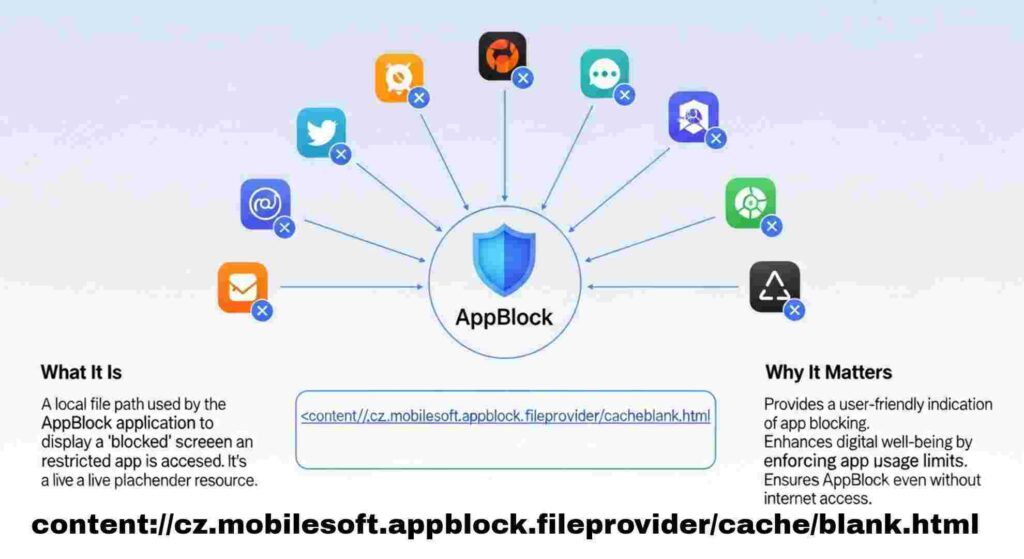In an era where privacy, focus, and digital wellness are paramount, mobile tools that manage app usage and distractions are becoming vital. If you’ve ever stumbled across the strange-looking URI content://cz.mobilesoft.appblock.fileprovider/cache/blank.html while using an Android device—perhaps while inspecting cache files or developer logs—you’re not alone. Despite how technical or obscure it sounds, this string carries practical implications for users of productivity tools like AppBlock.
In this post, we’ll dive deep into what this URI means, its relation to AppBlock, how Android handles content providers, and why it’s relevant to both casual users and developers. Whether you’re troubleshooting an issue, developing your own Android app, or simply curious, we’ll break down this topic in a way that’s accessible, accurate, and actionable.
What Is content://cz.mobilesoft.appblock.fileprovider/cache/blank.html?
Let’s start with the basics. This URI is a Content URI in Android—essentially, a way of referencing data (like files or media) inside apps in a secure, structured manner.
Let’s break down the parts:
-
content://: Indicates this is a content URI, which Android uses to access shared data.
-
cz.mobilesoft.appblock.fileprovider: This is the authority. It identifies the app providing access to the content—in this case, AppBlock, developed by MobileSoft.
-
/cache/blank.html: The file path. It tells us this is a cached HTML file named
blank.html, typically stored temporarily.
So, altogether, content://cz.mobilesoft.appblock.fileprovider/cache/blank.html is pointing to a temporary blank HTML file cached by the AppBlock app on your Android device.
But why does it exist in the first place? Let’s find out.
Why Does AppBlock Use a Cached Blank HTML File?
AppBlock is a popular digital wellbeing app that allows users to temporarily block distracting apps, websites, and notifications. Its purpose is simple: help users stay focused. But achieving that involves clever engineering under the hood.
Here’s where the cached blank.html comes into play:
-
Website Blocking: When users attempt to open a blocked website, AppBlock needs to intercept and redirect that request. Instead of loading the actual content, it often serves a minimal or blank page to avoid triggering distractions or loading scripts.
-
Efficiency: Serving a blank cached file (
blank.html) is faster and less resource-intensive than dynamically generating content every time a blocked action is triggered. -
System Compatibility: On Android, using
content://URIs ensures compatibility with Android’s FileProvider system, which manages secure file sharing between apps.
In essence, this content URI is part of a smart workaround that lets AppBlock discreetly block content without crashing apps or leaving users in a loop.
The Role of FileProvider in Android Apps
To fully understand the context of this URI, we need to explore FileProvider, a powerful Android component that allows secure file sharing between apps.
Why FileProvider Exists
Historically, apps could share files using file paths. But this raised security concerns. FileProvider was introduced to restrict direct file access and instead enforce a permissions-based system. Apps now use content URIs like content://cz.mobilesoft.appblock.fileprovider/... to refer to files, rather than raw paths.
How AppBlock Uses FileProvider
AppBlock leverages FileProvider to serve internal resources like cached HTML pages, particularly during website blocking. This approach ensures:
-
Security: The actual path of the file remains hidden from other apps.
-
Isolation: Files are sandboxed to prevent data leaks.
-
Control: AppBlock can monitor and manage how blocked content is delivered to the browser or WebView.
Using FileProvider is not just an Android best practice—it’s essential for apps that manage sensitive data, privacy, or user control.
What Happens If You Interact With This URI?
Many users find this URI while exploring log files, network requests, or content loading behavior inside browsers or restricted apps. But what happens if you try to open content://cz.mobilesoft.appblock.fileprovider/cache/blank.html?
Here’s what typically happens:
-
In Browsers: It may not resolve. Most browsers can’t interpret content URIs unless specifically granted permission via FileProvider.
-
In AppBlock’s Context: It silently serves a blank page to avoid distractions.
-
To Developers: This URI is a pointer—not meant to be directly opened by users, but useful for understanding how content is redirected.
So, for the average user, there’s no need to worry if you see this. But for developers or power users, it signals an internal process AppBlock uses to help you stay focused.
Is content://cz.mobilesoft.appblock.fileprovider/cache/blank.html a Security Risk?
This is a common concern—and the short answer is no, it’s not a security threat on its own.
Here’s why:
-
Limited Access: Content URIs are only accessible within the permission boundaries defined by the app.
-
No Personal Data:
blank.htmlis literally a blank file, containing no sensitive information. -
Temporary Nature: It’s stored in the cache directory, meaning Android may delete it automatically.
That said, any misconfigured FileProvider implementation could open up risks—but AppBlock, being a popular and vetted app, follows Android’s recommended best practices.
How to Troubleshoot Issues Related to This URI
Sometimes, power users or developers run into unexpected behavior involving content URIs. Here are some steps to troubleshoot:
1. Check AppBlock Permissions
Ensure AppBlock has the right permissions to manage web content. If permissions are revoked, redirections might fail.
2. Clear Cache
If the blank page isn’t rendering properly or redirects seem stuck, try clearing AppBlock’s cache via Android settings.
3. Reinstall the App
Misconfigured FileProvider references might get reset during a fresh install.
4. Enable Developer Options
For devs, use adb logcat to trace content URI behavior and confirm proper FileProvider setup in the manifest.
Developer Notes: Defining FileProvider in Your Own App
If you’re a developer inspired by AppBlock’s method and want to implement something similar, here’s a simplified example from Android’s best practices.
FileProvider Declaration in AndroidManifest.xml
file_paths.xml
This setup will allow your app to generate URIs like content://your.package.name.fileprovider/cache/blank.html.
The Bigger Picture: Why Understanding These URIs Matters
At first glance, this URI may seem like technical gibberish. But understanding how content URIs and FileProvider work unlocks deeper insight into Android’s privacy-first ecosystem. It shows how apps like AppBlock innovate to provide seamless, secure user experiences—without compromising performance or safety.
In 2025, as Android continues to tighten app permissions and sandboxing, using content:// URIs is not just a workaround—it’s a fundamental requirement for developers aiming to create responsible, user-centric apps.
Key Takeaways
| Point | Summary |
|---|---|
| What it is | A content URI pointing to a blank cached HTML file inside AppBlock. |
| Why it exists | Used for redirecting or blocking distracting content efficiently. |
| Security | It’s safe, non-malicious, and standard practice. |
| Who needs to know | Curious users, privacy-conscious individuals, developers building similar apps. |
| Use case | Prevents distractions by replacing content with blank HTML pages. |
Frequently Asked Questions
What is content://cz.mobilesoft.appblock.fileprovider/cache/blank.html used for?
It’s a reference to a cached blank HTML file used by AppBlock to block or redirect web content, helping users stay focused by avoiding distractions.
Is this file a virus or malware?
No, it’s a safe system-generated file used internally by AppBlock. It doesn’t pose any threat and contains no sensitive data.
Why is this URI appearing in my logs?
You may see this URI in logs if AppBlock is active and intercepting web requests or blocking content. It’s part of how the app operates behind the scenes.
Can I delete this file?
Yes, since it’s stored in the cache directory, you can safely clear AppBlock’s cache without affecting its core functionality.
Can I use similar methods in my own Android app?
Absolutely! By implementing Android’s FileProvider and using content URIs, you can safely serve files and manage content access—just like AppBlock.
What if this URI shows an error?
Try clearing the app cache or reinstalling the app. If you’re a developer, check your FileProvider configuration and permissions.
Final Thoughts
The next time you come across content://cz.mobilesoft.appblock.fileprovider/cache/blank.html, you’ll know it’s not an error or something suspicious—it’s actually a clever, secure way AppBlock enhances focus and digital wellbeing.
Understanding these small components gives us a glimpse into the bigger picture of app security, performance, and user experience in the Android ecosystem. Whether you’re a user seeking clarity or a developer building smarter tools, this insight can help you make better decisions—on both sides of the screen.

